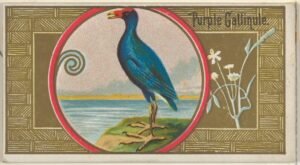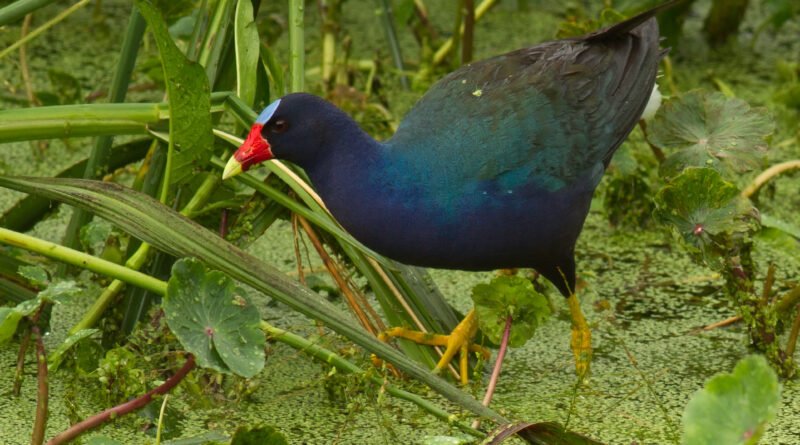Unraveling the Mysteries of the Purple Gallinule
I. Introduction
A. Introduction to the Purple Gallinule
The Purple Gallinule (Porphyrio martinicus) is a captivating wetland bird renowned for its vibrant plumage and distinctive appearance. It belongs to the rail family (Rallidae) and is closely related to other wetland species such as moorhens and coots.
B. Significance of Studying the Purple Gallinule
Understanding the ecology and behavior of the Purple Gallinule is crucial for conserving wetland ecosystems and protecting biodiversity. As an indicator species, changes in its population can reflect broader trends in wetland health and habitat quality.
II. Physical Characteristics
A. Plumage and Coloration
The Purple Gallinule boasts a striking array of colors, including shades of blue, green, purple, and red. Its body is adorned with iridescent feathers, while its bill is bright red with a yellow tip. These vibrant colors serve both ornamental and functional purposes, aiding in camouflage and mate attraction.
B. Morphological Adaptations
To thrive in its wetland habitat, the Purple Gallinule has evolved specialized physical features. Its long legs and toes enable it to walk on floating vegetation without sinking, while its broad wings provide stability during short flights over water.
III. Habitat and Distribution

A. Preferred Habitats Purple Gallinules inhabit a range of freshwater and brackish wetlands, including marshes, swamps, and mangroves. They are particularly fond of areas with dense vegetation, shallow water, and abundant food sources.
B. Geographic Distribution While primarily found in the southeastern United States, Purple Gallinules also inhabit wetlands throughout Central and South America. Their distribution is influenced by factors such as climate, habitat availability, and seasonal migration patterns.
IV. Feeding Behavior
A. Diet Composition Purple Gallinules are omnivorous birds with a diverse diet. They feed on a variety of plant and animal matter, including seeds, fruits, insects, small fish, frogs, and aquatic vegetation. This dietary flexibility allows them to adapt to changing environmental conditions.
B. Foraging Techniques Using their long toes and agile beaks, Purple Gallinules forage for food in shallow water and among dense vegetation. They employ a combination of probing, pecking, and grasping to capture prey and extract edible items from their surroundings.
V. Reproduction and Nesting
A. Breeding Season Breeding typically occurs during the warmer months when food resources are abundant and nesting sites are available. Purple Gallinules form monogamous pairs and engage in courtship displays to attract mates and establish territories.
B. Nest Construction Nests are constructed from floating vegetation such as reeds, grasses, and cattails, providing a stable platform above the water’s surface. Both parents contribute to nest-building and incubating the eggs, which hatch after a period of approximately three weeks.
VI. Vocalizations and Communication
A. Repertoire of Calls Purple Gallinules are highly vocal birds, using a variety of calls and vocalizations to communicate with each other. Their vocal repertoire includes loud squawks, clucks, and whistles, which serve to establish territory, signal alarm, and maintain social bonds within the group.
B. Behavioral Significance Vocalizations play a crucial role in Purple Gallinule behavior, facilitating mate selection, territory defense, and coordination within breeding pairs. These vocal signals are essential for maintaining social cohesion and ensuring reproductive success.
VII. Conservation Status and Threats

A. Conservation Status While currently classified as a species of least concern by the International Union for Conservation of Nature (IUCN), Purple Gallinules face numerous threats to their long-term survival. Habitat loss, pollution, invasive species, and climate change all pose significant challenges to their continued existence.
B. Habitat Loss and Fragmentation The conversion of wetlands for agriculture, urban development, and infrastructure projects represents a significant threat to Purple Gallinule habitats. Wetland drainage, pollution, and invasive species further degrade habitat quality and fragment populations, reducing breeding success and genetic diversity.
VIII. Ecological Role
A. Ecosystem Services Purple Gallinules play a vital role in wetland ecosystems, contributing to nutrient cycling, seed dispersal, and predator control. As omnivorous birds, they help regulate insect populations, control aquatic vegetation, and provide food for other wetland species.
B. Conservation Implications Preserving and restoring wetland habitats is essential for ensuring the continued survival of Purple Gallinules and maintaining the ecological balance of their ecosystems. Conservation efforts focused on habitat protection, restoration, and sustainable management are critical for mitigating threats and safeguarding the species for future generations.
IX. Conclusion
A. Recap of Key Insights The Purple Gallinule is a remarkable wetland bird with unique characteristics and behaviors. From its vibrant plumage to its important ecological role, the Purple Gallinule enriches wetland ecosystems and serves as a symbol of the importance of conserving these valuable habitats.
B. Call to Action Encourage readers to support conservation efforts aimed at protecting wetland habitats and preserving the biodiversity of species like the Purple Gallinule. By raising awareness, promoting sustainable practices, and advocating for habitat preservation, we can ensure a brighter future for wetland ecosystems and the species that depend on them.

